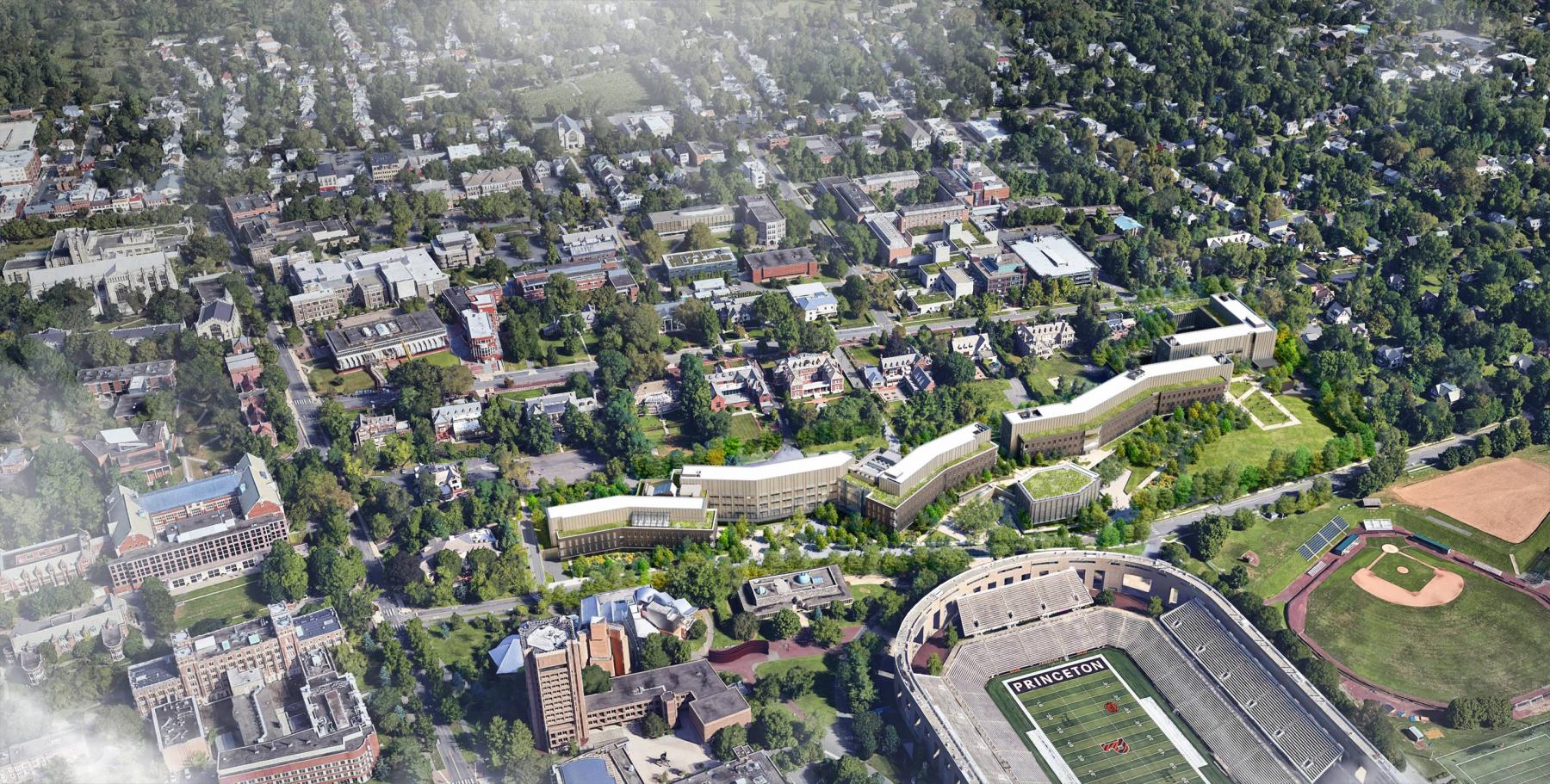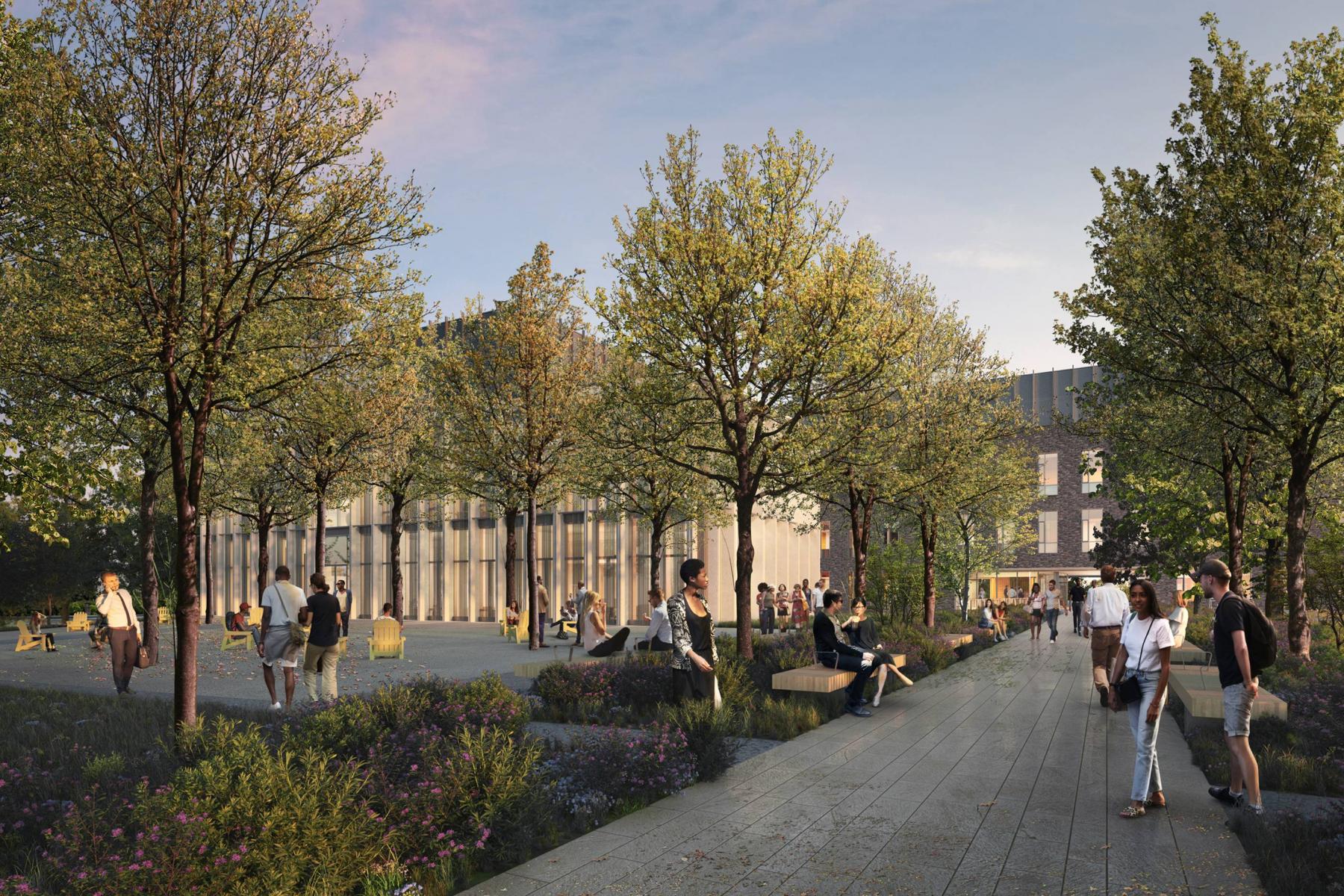
New engineering and environmental studies facilities will support innovative research that benefits society
From addressing climate change to developing new ways of delivering vaccines, Princeton’s proposed engineering and environmental studies project will enable breakthrough teaching and research in the service of humanity while enhancing the public experience of the surrounding neighborhood.
The University plans to build a new home for Environmental Studies (ES) and the School of Engineering and Applied Science (SEAS) between Ivy Lane and Prospect Avenue. The four buildings — environmental science, bioengineering, chemical and biological engineering, and an engineering commons — will create a new ES + SEAS neighborhood carefully integrated into the surrounding landscape with strong connections to outdoor spaces.
The buildings will include state-of-the-art teaching, research and collaboration facilities for seven academic departments, institutes and centers.

The four buildings — environmental science, bioengineering, chemical and biological engineering, and an engineering commons — will create a new ES + SEAS neighborhood carefully integrated into the surrounding landscape with strong connections to outdoor spaces. This rendering shows an aerial view of the proposed buildings, which will create a neighborhood that more closely connects engineering and environmental studies with the rest of campus to foster collaboration with the natural sciences, humanities, public policy and other disciplines.
Images courtesy of Ennead Architects LLP/bloomimages
SEAS Dean Andrea Goldsmith said the new facilities are essential to conducting research that has tremendous benefits to human health and society — including work addressing climate change and carbon sequestration, new pharmaceuticals and vaccines, better processes for the production of new materials, and greater energy efficiency. The new buildings also will further environmental science studies that are crucial to learning about and mitigating global challenges related to biodiversity, conservation, climate, energy, and environmental policy.
“We are at a point where the current facilities for engineering are 60 years old. They are no longer sufficient to do the groundbreaking research that we want to accomplish,” said Goldsmith, the Arthur LeGrand Doty Professor of Electrical Engineering. “The reason that Princeton Engineering needs to grow is that engineering has changed. In the last decades, engineering has become much more interdisciplinary. It is solving much more complex problems that require a broader set of expertise, of disciplinary and interdisciplinary expertise.”
Goldsmith said that the neighborhood’s central location is critical to convene expertise across the sciences, humanities and public policy. “All the richness of ideas we need to solve the problems we face. This project is really about maximizing our impact and delivering on Princeton’s motto to benefit humanity, through engineering and technology,” she added.
The project reflects the importance of environmental studies and engineering in a 21st century liberal arts university. The buildings will create a neighborhood that more closely connects engineering and environmental studies with the rest of the University’s campus, including the new home for the Department of Computer Science.
“The location of the building, really, is at the intersection of the sciences, engineering, public policy and the humanities,” said Lars Hedin, the George M. Moffett Professor of Biology. “It’s designed to be a magnet for bringing these groups together. And this will kind of be the cauldron of forging new fields, new ideas and new interactions.” Hedin is chair of the Department of Ecology and Evolutionary Biology and a professor in the High Meadows Environmental Institute.
The proximity of key collaborators in different departments also amplifies connections between the growing fields of bioengineering, data science and environmental research and creates a center of gravity for convening diverse experts and innovators across and beyond the University to address critical societal needs.
“It is really designed around connectivity,” said University Architect Ronald McCoy. The new buildings, all connected underground in one continuous sequence, will maintain distinct identities for disciplines while allowing for strong connections among them.
“When we spoke to the faculty they were really clear: ‘We need better space and we need more of it.’ These are state-of-the-art, flexible, and highly functional teaching and research spaces,” McCoy said.
Athanassios (Thanos) Panagiotopoulos, chair of the Department of Chemical and Biological Engineering, said the new teaching, research, lab and collaboration spaces are “absolutely critical to the mission of the University to serve society by addressing urgent needs.”
“Our department’s work is about mitigating climate change, creating new chemical processes that will allow us to replace fossil fuels with renewables, and giving us the tools to address public health and wellbeing,” said Panagiotopoulos, the Susan Dod Brown Professor of Chemical and Biological Engineering. “The technologies that enable the Covid vaccines to become quickly, widely and safely available -- the ability to protect those tiny mRNA packages – uses technology that chemical engineers have developed.”
With the aid of animations and renderings, Princeton professors and the University architect explain how new buildings will support teaching and research in fields ranging from climate science to bioengineering.
Director of the Princeton Bioengineering Initiative Cliff Brangwynne said the ES + SEAS project will help support cutting edge research for the future.
“If you ask people ‘what are the important areas for the 21st century?’ it’s clearly computational work, computer science and biological engineering. These are the things that are going to transform society,” said Brangwynne, who is also the June K. Wu ’92 Professor in Engineering and a professor of chemical and biological engineering. “Right now, we’re in the middle of a pandemic. That is the kind of challenge faced by society that requires cutting-edge research at the interface of biology and engineering [such as the COVID-19 vaccine technology]. And, in order to achieve our goals on this front, we need to recruit top-notch researchers. That is going to be impossible without the infrastructure to attract these researchers.”
The ES + SEAS project is also a model of the University’s sustainability ethos. The complex meets or exceeds Princeton sustainability standards and will seek LEED certification. It will feature geo-exchange heating and cooling, a green roof, high performance exteriors, rainwater harvesting and sustainable materials.
The design also reflects the University’s strong commitment to being a steward of buildings and landscapes while pursuing critical opportunities for innovation, creativity and benefit to society.
The buildings will be terraced into the hillside between Prospect Avenue and Ivy Lane currently occupied by faculty and staff housing and parking lots behind eating club buildings. As part of the project’s careful, thoughtful planning and design process, the University is planning to relocate the Office of the Dean for Research building at 91 Prospect Avenue to across the street, allowing for it to remain part of a vibrant Prospect Avenue.
The neighborhood will include sunken courtyards and extensive pedestrian paths and outdoor spaces for the public and community. The complex also includes public display spaces for interaction with school groups and the community, as well as lecture halls for public outreach and engagement.

This architect’s rendering shows the Prospect Avenue entry of the proposed ES + SEAS neighborhood. The ES + SEAS project is also a model of the University’s sustainability ethos and sustainable building standards.
Image courtesy of Ennead Architects LLP/bloomimages


